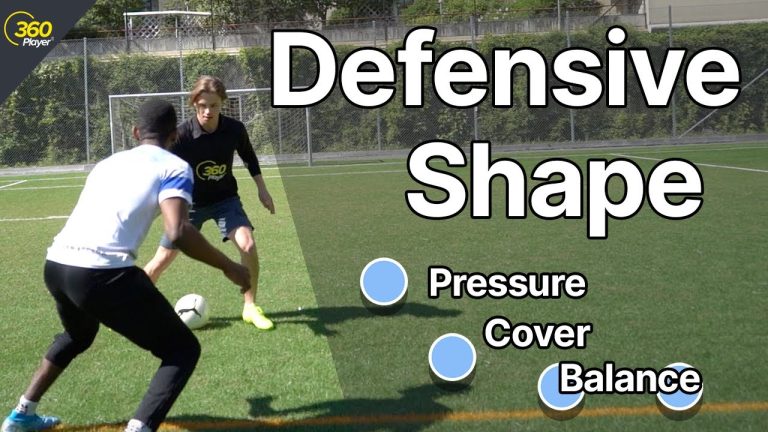Communication plays a pivotal role in the art of defensive clearances. When it comes to swiftly and effectively dealing with potential threats on the pitch, clear and concise communication amongst defenders is paramount. It not only allows for coordinated movements and strategic positioning but also minimizes the risk of defensive errors. In this article, we delve into the crucial role of communication in defensive clearances and how it can be the difference between a successful interception and a costly mistake.
What is the meaning of squeeze in football?
In football, the term “squeeze” refers to the movement of a team up the pitch, specifically towards the opposition goal. This strategic maneuver is often communicated by stating the number of yards to be covered, such as “Squeeze 5.” By executing the squeeze, players aim to apply pressure on the opposing team and create opportunities for scoring. It is an effective tactic that requires coordination and synchronization among the team members.
Another related term in football is “shuffle,” which entails sliding over towards the ball as a collective unit without dropping or squeezing. The shuffle is a tactical move where the entire team shifts together to maintain defensive balance or create offensive opportunities. By shuffling, players can adjust their positions on the field without compromising their formation or leaving gaps in their defense. It is a crucial technique that showcases the team’s cohesion and coordination, allowing them to maintain control and respond effectively to the game’s dynamics.
What is the meaning of clearing the ball?
Clearing the ball is a crucial defensive strategy in sports like soccer and hockey. It refers to the act of kicking or hitting the ball out of your team’s defensive zone, towards the opponent’s side of the field. By doing so, you remove the immediate threat to your goal and create an opportunity for your team to regroup and regain control of the game. Clearing the ball effectively requires technique, precision, and quick decision-making, making it a skill that separates great defenders from the rest.
In soccer, clearing the ball is often seen as a last resort when under pressure from the opposing team. It involves making a powerful and accurate kick to get the ball as far away from your goal as possible. This not only buys your team some time to reorganize defensively but also denies the opponent any immediate scoring opportunities. Clearing the ball can be a risky move, as it may give possession back to the other team, but it is a necessary tactic when defending against relentless attacks.
Similarly, in hockey, clearing the ball is a defensive maneuver used to relieve pressure when the opposing team is close to scoring. It involves quickly hitting the puck out of your defensive zone and into the neutral or offensive zone. Clearing the puck requires good stick handling skills, as well as the ability to make accurate passes or shots while under pressure. By successfully clearing the puck, you not only prevent the opposing team from scoring but also create a chance for your team to counterattack and regain control of the game.
In conclusion, clearing the ball is a vital defensive strategy in sports like soccer and hockey. It involves removing the ball from your team’s defensive zone towards the opponent’s side, creating an opportunity for your team to regroup and regain control. Whether it’s a powerful kick in soccer or a well-timed hit in hockey, clearing the ball requires skill, precision, and quick decision-making. By mastering this technique, defenders can effectively protect their goal and contribute to their team’s success.
Can a soccer ball be deflated safely?
Deflating a soccer ball is not recommended as it can negatively impact the ball’s performance and durability. When a ball is deflated, it loses its optimal shape and bounce, leading to a compromised playing experience. Additionally, deflation can cause damage to the ball’s structure, resulting in a shorter lifespan. Therefore, it is best to maintain proper inflation levels to ensure a satisfying and long-lasting game on the field.
Unlocking Victory: How Effective Communication Drives Defensive Clearances
Unlocking Victory: How Effective Communication Drives Defensive Clearances
In the heat of a soccer match, effective communication becomes the catalyst for success, particularly when it comes to defensive clearances. A team’s ability to swiftly and accurately communicate with one another on the field can make all the difference in preventing the opposition from scoring. By employing concise and clear instructions, players can coordinate their movements, anticipate each other’s actions, and strategically clear the ball out of danger. This level of communication not only ensures a cohesive defensive unit but also instills confidence and trust among teammates, ultimately unlocking the path to victory.
The Power of Words: Enhancing Defensive Clearances Through Communication
In the high-intensity game of football, effective communication holds the key to enhancing defensive clearances. The power of words on the field can significantly improve coordination and anticipation among teammates, leading to more successful interceptions and tackles. By constantly exchanging information, defenders are able to anticipate the movements of their opponents, closing down gaps and preventing potential attacks. Clear and concise communication allows defenders to quickly react to changing situations, ensuring efficient and accurate clearances. Therefore, harnessing the power of words is not just a matter of enhancing defensive strategies, but also a means to foster a cohesive and united team, working towards a common goal of victory.
Mastering the Art: Communication Strategies for Optimal Defensive Clearances
Mastering the art of defensive clearances requires impeccable communication strategies to ensure optimal results on the field. A cohesive defensive unit must possess the ability to communicate effectively and concisely, allowing for clean and decisive clearances. By employing clear hand signals, verbal cues, and a deep understanding of each other’s movements, defenders can coordinate seamlessly to execute precise clearances that eliminate any threat posed by the opposition. The art lies in the ability to convey information swiftly and accurately, enabling the team to maintain control, create counter-attacking opportunities, and ultimately secure victory.
Building a Strong Defense: The Role of Communication in Clearing the Path to Success
Building a Strong Defense: The Role of Communication in Clearing the Path to Success
In the pursuit of success, effective communication serves as the cornerstone of building a strong defense. Clear and concise communication not only ensures that ideas are conveyed accurately, but also paves the way for collaboration, understanding, and ultimately achieving desired outcomes. Whether it is in the workplace, personal relationships, or even within oneself, the power of communication lies in its ability to bridge gaps, resolve conflicts, and foster a shared vision. By honing our communication skills, we can dismantle barriers, foster trust, and create an environment conducive to growth and prosperity. Thus, in the journey towards success, communication acts as the catalyst, clearing the path and laying the foundation for achievement.
In the realm of defensive clearances, effective communication stands as an indispensable ally, facilitating seamless coordination and minimizing errors on the pitch. By fostering a shared understanding and providing crucial information, it empowers defenders to make informed decisions swiftly and efficiently. From precise calls for marking assignments to timely alerts regarding incoming threats, communication serves as the invisible force that binds the defensive line together, ensuring a solid, impenetrable shield. With its pivotal role in enhancing defensive prowess, the power of communication cannot be overstated, as it remains the linchpin in achieving resounding success on the football field.




